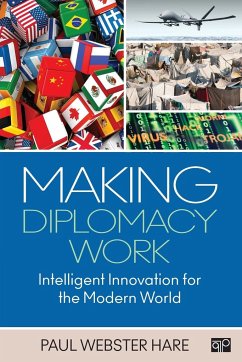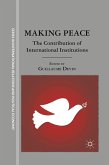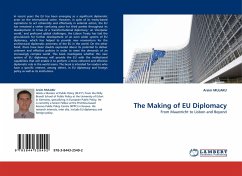- Broschiertes Buch
- Merkliste
- Auf die Merkliste
- Bewerten Bewerten
- Teilen
- Produkt teilen
- Produkterinnerung
- Produkterinnerung
Making Diplomacy Work: Intelligent Innovation for the Modern World takes a fresh look at the practice of diplomacy, setting it in its contemporary context and analyzing the major factors that have changed the nature of the way it is conducted. The book is built on the premise that diplomacy must adapt some of its ritualistic and stale procedures to become more effective in the modern world. It provides a thorough examination of current issues from a diplomatic perspective and offers an extensive array of real-world examples. Author Paul Webster Hare brings 30 years of diplomacy experience to…mehr
Andere Kunden interessierten sich auch für
![Saudi Arabia and Iran Saudi Arabia and Iran]() Banafsheh KeynoushSaudi Arabia and Iran21,99 €
Banafsheh KeynoushSaudi Arabia and Iran21,99 €![International Relations of Japan International Relations of Japan]() Kathleen NewlandInternational Relations of Japan45,99 €
Kathleen NewlandInternational Relations of Japan45,99 €![LIFE AND WORK IN POST-SOVIET RUSSIA LIFE AND WORK IN POST-SOVIET RUSSIA]() Chris CheangLIFE AND WORK IN POST-SOVIET RUSSIA106,99 €
Chris CheangLIFE AND WORK IN POST-SOVIET RUSSIA106,99 €![Making Peace Making Peace]() Making Peace38,99 €
Making Peace38,99 €![LIFE AND WORK IN POST-SOVIET RUSSIA LIFE AND WORK IN POST-SOVIET RUSSIA]() Chris CheangLIFE AND WORK IN POST-SOVIET RUSSIA61,99 €
Chris CheangLIFE AND WORK IN POST-SOVIET RUSSIA61,99 €![The Making of EU Diplomacy The Making of EU Diplomacy]() Arsim MULAKUThe Making of EU Diplomacy32,99 €
Arsim MULAKUThe Making of EU Diplomacy32,99 €![International Relations in Perspective International Relations in Perspective]() Henry R. NauInternational Relations in Perspective130,99 €
Henry R. NauInternational Relations in Perspective130,99 €-
-
-
Making Diplomacy Work: Intelligent Innovation for the Modern World takes a fresh look at the practice of diplomacy, setting it in its contemporary context and analyzing the major factors that have changed the nature of the way it is conducted. The book is built on the premise that diplomacy must adapt some of its ritualistic and stale procedures to become more effective in the modern world. It provides a thorough examination of current issues from a diplomatic perspective and offers an extensive array of real-world examples. Author Paul Webster Hare brings 30 years of diplomacy experience to this title; it is a must-have volume for any student of diplomacy.
Hinweis: Dieser Artikel kann nur an eine deutsche Lieferadresse ausgeliefert werden.
Hinweis: Dieser Artikel kann nur an eine deutsche Lieferadresse ausgeliefert werden.
Produktdetails
- Produktdetails
- Verlag: CQ Press
- Seitenzahl: 418
- Erscheinungstermin: 11. Februar 2015
- Englisch
- Abmessung: 229mm x 152mm x 22mm
- Gewicht: 603g
- ISBN-13: 9781452276489
- ISBN-10: 145227648X
- Artikelnr.: 41622889
- Herstellerkennzeichnung
- Libri GmbH
- Europaallee 1
- 36244 Bad Hersfeld
- gpsr@libri.de
- Verlag: CQ Press
- Seitenzahl: 418
- Erscheinungstermin: 11. Februar 2015
- Englisch
- Abmessung: 229mm x 152mm x 22mm
- Gewicht: 603g
- ISBN-13: 9781452276489
- ISBN-10: 145227648X
- Artikelnr.: 41622889
- Herstellerkennzeichnung
- Libri GmbH
- Europaallee 1
- 36244 Bad Hersfeld
- gpsr@libri.de
Paul Webster Hare teaches courses on Cuba in transition, on diplomacy, and on arms control at Boston University. A British diplomat for 30 years, Hare served overseas at the UK Representation to the EU in Brussels, Portugal, New York, and Venezuela as Deputy Head of Mission. He was head of the Foreign Office's Non-Proliferation Department and the first project director for the UK's presence at the Shanghai World Expo in 2010. From 2001-2004, Hare served as the British ambassador to Cuba. He is a fellow of the Weatherhead Center for International Affairs at Harvard University and a member of the Brookings Institution Core Group on Cuba and has been designated a lieutenant of the Royal Victorian Order by Her Majesty Queen Elizabeth II. In addition, Ambassador Hare was president of the British Baseball Federation from 2000-2001.
Preface
Acknowledgments
Introduction
About the Author
Chapter 1: Diplomacy in History
The Building Blocks of Modern Diplomacy
Diplomacy and Collective Action
Revolutions, Wars, and the Changing World
States and Leaders Decline
Diplomacy and Foreign Policy
Suggestions for Further Reading
Chapter 2: Who Are the Diplomats and How Do They Operate?
The Evolution of the Diplomatic Cadre
The Use of Intelligence
Professionals or Politicians?
Diplomatic Privileges and Immunities
The VCDR and VCCR
What Is Changing In Diplomats' Behavior?
Diplomatic Asylum
Case Studies
... And Personally
Suggestions for Further Reading
Chapter 3: The Institutions of Bilateral Diplomacy - Precedence, Protocol,
Ministries, Embassies
Ministries
The Modern Ministries of Foreign Affairs
Examples of Ministries of Foreign Affairs in Action
Roles of Embassies and Consulates
Embassies Losing Their Grip?
How Are Embassies Staffed?
New and Old Tasks
Competition
The Future of Diplomatic Missions
Case Studies - How Embassies Operate
Nevertheless Useful
Suggestions for Further Reading
Chapter 4: The Institutions of Multilateral Diplomacy
The United Nations
The Charter of the United Nations
The Organs of the UN
The Security Council
ESOSOC
International Court Of Justice
The UN Secretariat
Diplomats and the UN
The UN's Development
Different Worlds: Different UN
Case Studies: The Charter And The UNSCR: The Iraq Crises of 1990-2001 and
2003
Following Diplomatic and Military Success: New Tasks
UNSCOM and UNMOVIC Success
Conclusion
Suggestions for Further Reading
Chapter 5: Regional Diplomacy and the Gs. The Rise of Summitry
The Non-Aligned Movement
The European Union
Special Competencies
The EU and Domestic Policies
The EU Institutions: A Modern Crisis of Supranational Diplomacy?
Is Accountability a Part of the EU?
The EU's Success in Diplomacy
The EU as a Diplomatic Service
The EU Case Studies
The EU Case Studies
The African Union
Asean
Latin America
Other Regions
Other Groups
Summits and the Gs
Innovation from Groups
Issue Groups
Suggestions for Further Reading
Chapter 6: Negotiations
Framing an Issue
The Raw Material of Diplomatic Negotiations
Culture
Elements Required For Success: Pre-Negotiations
Mediation
Strategy and Progress
Case Study: The INF Negotiation 1980-1987
Continuous Negotiation
Case Study: Negotiation in Cuba
Suggestions for Further Reading
Chapter 7: Public Diplomacy
Public Diplomacy in the Past
Propaganda?
Public Diplomacy for Today's World
Effective Public Diplomacy
Public Diplomacy in Practice
Conclusions and Case Studies
Unlimited Ideas
Suggestions for Further Reading
Chapter 8: Public Goods: Treaties and International Law
Treaties
Laws, Rules, and Diplomacy
War and Its Rules
The United Nations
Genocide
Terrorism
Human Rights
Non-Proliferation of Nuclear Weapons
Climate Change
World Trade/World Finance
Diplomacy and Law: The Problem of Enforcement and Implementation
Suggestions for Further Reading
Chapter 9: The New Diplomatic Agenda: The Challenges for Diplomatic Reform
Why Reform?
Diplomatic Priorities
The New Agenda - Corruption
Decline of Sovereign States
The New Agenda? Diplomacy Steps Up
Diplomatic Reform
Sovereign Wealth Funds
Development Assistance in the Diplomatic Agenda
Case Study of the New Agenda - Nation Building in Afghanistan
Conclusion
Suggestions for Further Reading
Chapter 10: The Non-State Actors: Global Citizens and Global Diplomacy
The Globalization of Identity - The International Community?
The Non-State Actors
Global Citizens?
States and Non-States in Diplomacy
Beyond States - The Non-State Advantage?
The Battle Of Ideas - States v. Non-States?
Common Need: Common Reform
Case Study - Haiti and the Earthquake - State and Non-State, The Republic
Of NGOs, The Alms
Merchant
Conclusion
Haiti and Rwanda
Suggestions for Further Reading
Chapter 11: The Continuing Information and Communication Revolution -
Awaiting the Response of Diplomacy
The ICR and E-Diplomacy
International Chatter
The ICR and A Shrinking World
Diplomacy and the Apps
Oh - And What about Radio and Television?
Global Governance of the ICR
The Positives and Negatives For Diplomacy - Communications Unlocks
Potential And Produces
New Weapons
Communications: It's A Small World: The Global Whistle Blower and Global
Activism
Conclusion
Suggestions for Further Reading
Chapter 12: Diplomacy in 2025
Diplomacy in 1945
The Reassertion of Diplomacy
Diplomacy Still Valid for 2025
Looking At the Future - The Issue of Stovepipes
Complex Issues or Inadequate Diplomacy?
The Forums for Discussion
Permanent Crises
Future Crises
Intelligent, Versatile, Resourceful: The Diplomat In 2025
Suggestions for Further Reading
Chapter 13: Diplomacy for the Ages
15 Ideas to Raise Diplomacy's Batting Average
Final Thoughts
Acknowledgments
Introduction
About the Author
Chapter 1: Diplomacy in History
The Building Blocks of Modern Diplomacy
Diplomacy and Collective Action
Revolutions, Wars, and the Changing World
States and Leaders Decline
Diplomacy and Foreign Policy
Suggestions for Further Reading
Chapter 2: Who Are the Diplomats and How Do They Operate?
The Evolution of the Diplomatic Cadre
The Use of Intelligence
Professionals or Politicians?
Diplomatic Privileges and Immunities
The VCDR and VCCR
What Is Changing In Diplomats' Behavior?
Diplomatic Asylum
Case Studies
... And Personally
Suggestions for Further Reading
Chapter 3: The Institutions of Bilateral Diplomacy - Precedence, Protocol,
Ministries, Embassies
Ministries
The Modern Ministries of Foreign Affairs
Examples of Ministries of Foreign Affairs in Action
Roles of Embassies and Consulates
Embassies Losing Their Grip?
How Are Embassies Staffed?
New and Old Tasks
Competition
The Future of Diplomatic Missions
Case Studies - How Embassies Operate
Nevertheless Useful
Suggestions for Further Reading
Chapter 4: The Institutions of Multilateral Diplomacy
The United Nations
The Charter of the United Nations
The Organs of the UN
The Security Council
ESOSOC
International Court Of Justice
The UN Secretariat
Diplomats and the UN
The UN's Development
Different Worlds: Different UN
Case Studies: The Charter And The UNSCR: The Iraq Crises of 1990-2001 and
2003
Following Diplomatic and Military Success: New Tasks
UNSCOM and UNMOVIC Success
Conclusion
Suggestions for Further Reading
Chapter 5: Regional Diplomacy and the Gs. The Rise of Summitry
The Non-Aligned Movement
The European Union
Special Competencies
The EU and Domestic Policies
The EU Institutions: A Modern Crisis of Supranational Diplomacy?
Is Accountability a Part of the EU?
The EU's Success in Diplomacy
The EU as a Diplomatic Service
The EU Case Studies
The EU Case Studies
The African Union
Asean
Latin America
Other Regions
Other Groups
Summits and the Gs
Innovation from Groups
Issue Groups
Suggestions for Further Reading
Chapter 6: Negotiations
Framing an Issue
The Raw Material of Diplomatic Negotiations
Culture
Elements Required For Success: Pre-Negotiations
Mediation
Strategy and Progress
Case Study: The INF Negotiation 1980-1987
Continuous Negotiation
Case Study: Negotiation in Cuba
Suggestions for Further Reading
Chapter 7: Public Diplomacy
Public Diplomacy in the Past
Propaganda?
Public Diplomacy for Today's World
Effective Public Diplomacy
Public Diplomacy in Practice
Conclusions and Case Studies
Unlimited Ideas
Suggestions for Further Reading
Chapter 8: Public Goods: Treaties and International Law
Treaties
Laws, Rules, and Diplomacy
War and Its Rules
The United Nations
Genocide
Terrorism
Human Rights
Non-Proliferation of Nuclear Weapons
Climate Change
World Trade/World Finance
Diplomacy and Law: The Problem of Enforcement and Implementation
Suggestions for Further Reading
Chapter 9: The New Diplomatic Agenda: The Challenges for Diplomatic Reform
Why Reform?
Diplomatic Priorities
The New Agenda - Corruption
Decline of Sovereign States
The New Agenda? Diplomacy Steps Up
Diplomatic Reform
Sovereign Wealth Funds
Development Assistance in the Diplomatic Agenda
Case Study of the New Agenda - Nation Building in Afghanistan
Conclusion
Suggestions for Further Reading
Chapter 10: The Non-State Actors: Global Citizens and Global Diplomacy
The Globalization of Identity - The International Community?
The Non-State Actors
Global Citizens?
States and Non-States in Diplomacy
Beyond States - The Non-State Advantage?
The Battle Of Ideas - States v. Non-States?
Common Need: Common Reform
Case Study - Haiti and the Earthquake - State and Non-State, The Republic
Of NGOs, The Alms
Merchant
Conclusion
Haiti and Rwanda
Suggestions for Further Reading
Chapter 11: The Continuing Information and Communication Revolution -
Awaiting the Response of Diplomacy
The ICR and E-Diplomacy
International Chatter
The ICR and A Shrinking World
Diplomacy and the Apps
Oh - And What about Radio and Television?
Global Governance of the ICR
The Positives and Negatives For Diplomacy - Communications Unlocks
Potential And Produces
New Weapons
Communications: It's A Small World: The Global Whistle Blower and Global
Activism
Conclusion
Suggestions for Further Reading
Chapter 12: Diplomacy in 2025
Diplomacy in 1945
The Reassertion of Diplomacy
Diplomacy Still Valid for 2025
Looking At the Future - The Issue of Stovepipes
Complex Issues or Inadequate Diplomacy?
The Forums for Discussion
Permanent Crises
Future Crises
Intelligent, Versatile, Resourceful: The Diplomat In 2025
Suggestions for Further Reading
Chapter 13: Diplomacy for the Ages
15 Ideas to Raise Diplomacy's Batting Average
Final Thoughts
Preface
Acknowledgments
Introduction
About the Author
Chapter 1: Diplomacy in History
The Building Blocks of Modern Diplomacy
Diplomacy and Collective Action
Revolutions, Wars, and the Changing World
States and Leaders Decline
Diplomacy and Foreign Policy
Suggestions for Further Reading
Chapter 2: Who Are the Diplomats and How Do They Operate?
The Evolution of the Diplomatic Cadre
The Use of Intelligence
Professionals or Politicians?
Diplomatic Privileges and Immunities
The VCDR and VCCR
What Is Changing In Diplomats' Behavior?
Diplomatic Asylum
Case Studies
... And Personally
Suggestions for Further Reading
Chapter 3: The Institutions of Bilateral Diplomacy - Precedence, Protocol,
Ministries, Embassies
Ministries
The Modern Ministries of Foreign Affairs
Examples of Ministries of Foreign Affairs in Action
Roles of Embassies and Consulates
Embassies Losing Their Grip?
How Are Embassies Staffed?
New and Old Tasks
Competition
The Future of Diplomatic Missions
Case Studies - How Embassies Operate
Nevertheless Useful
Suggestions for Further Reading
Chapter 4: The Institutions of Multilateral Diplomacy
The United Nations
The Charter of the United Nations
The Organs of the UN
The Security Council
ESOSOC
International Court Of Justice
The UN Secretariat
Diplomats and the UN
The UN's Development
Different Worlds: Different UN
Case Studies: The Charter And The UNSCR: The Iraq Crises of 1990-2001 and
2003
Following Diplomatic and Military Success: New Tasks
UNSCOM and UNMOVIC Success
Conclusion
Suggestions for Further Reading
Chapter 5: Regional Diplomacy and the Gs. The Rise of Summitry
The Non-Aligned Movement
The European Union
Special Competencies
The EU and Domestic Policies
The EU Institutions: A Modern Crisis of Supranational Diplomacy?
Is Accountability a Part of the EU?
The EU's Success in Diplomacy
The EU as a Diplomatic Service
The EU Case Studies
The EU Case Studies
The African Union
Asean
Latin America
Other Regions
Other Groups
Summits and the Gs
Innovation from Groups
Issue Groups
Suggestions for Further Reading
Chapter 6: Negotiations
Framing an Issue
The Raw Material of Diplomatic Negotiations
Culture
Elements Required For Success: Pre-Negotiations
Mediation
Strategy and Progress
Case Study: The INF Negotiation 1980-1987
Continuous Negotiation
Case Study: Negotiation in Cuba
Suggestions for Further Reading
Chapter 7: Public Diplomacy
Public Diplomacy in the Past
Propaganda?
Public Diplomacy for Today's World
Effective Public Diplomacy
Public Diplomacy in Practice
Conclusions and Case Studies
Unlimited Ideas
Suggestions for Further Reading
Chapter 8: Public Goods: Treaties and International Law
Treaties
Laws, Rules, and Diplomacy
War and Its Rules
The United Nations
Genocide
Terrorism
Human Rights
Non-Proliferation of Nuclear Weapons
Climate Change
World Trade/World Finance
Diplomacy and Law: The Problem of Enforcement and Implementation
Suggestions for Further Reading
Chapter 9: The New Diplomatic Agenda: The Challenges for Diplomatic Reform
Why Reform?
Diplomatic Priorities
The New Agenda - Corruption
Decline of Sovereign States
The New Agenda? Diplomacy Steps Up
Diplomatic Reform
Sovereign Wealth Funds
Development Assistance in the Diplomatic Agenda
Case Study of the New Agenda - Nation Building in Afghanistan
Conclusion
Suggestions for Further Reading
Chapter 10: The Non-State Actors: Global Citizens and Global Diplomacy
The Globalization of Identity - The International Community?
The Non-State Actors
Global Citizens?
States and Non-States in Diplomacy
Beyond States - The Non-State Advantage?
The Battle Of Ideas - States v. Non-States?
Common Need: Common Reform
Case Study - Haiti and the Earthquake - State and Non-State, The Republic
Of NGOs, The Alms
Merchant
Conclusion
Haiti and Rwanda
Suggestions for Further Reading
Chapter 11: The Continuing Information and Communication Revolution -
Awaiting the Response of Diplomacy
The ICR and E-Diplomacy
International Chatter
The ICR and A Shrinking World
Diplomacy and the Apps
Oh - And What about Radio and Television?
Global Governance of the ICR
The Positives and Negatives For Diplomacy - Communications Unlocks
Potential And Produces
New Weapons
Communications: It's A Small World: The Global Whistle Blower and Global
Activism
Conclusion
Suggestions for Further Reading
Chapter 12: Diplomacy in 2025
Diplomacy in 1945
The Reassertion of Diplomacy
Diplomacy Still Valid for 2025
Looking At the Future - The Issue of Stovepipes
Complex Issues or Inadequate Diplomacy?
The Forums for Discussion
Permanent Crises
Future Crises
Intelligent, Versatile, Resourceful: The Diplomat In 2025
Suggestions for Further Reading
Chapter 13: Diplomacy for the Ages
15 Ideas to Raise Diplomacy's Batting Average
Final Thoughts
Acknowledgments
Introduction
About the Author
Chapter 1: Diplomacy in History
The Building Blocks of Modern Diplomacy
Diplomacy and Collective Action
Revolutions, Wars, and the Changing World
States and Leaders Decline
Diplomacy and Foreign Policy
Suggestions for Further Reading
Chapter 2: Who Are the Diplomats and How Do They Operate?
The Evolution of the Diplomatic Cadre
The Use of Intelligence
Professionals or Politicians?
Diplomatic Privileges and Immunities
The VCDR and VCCR
What Is Changing In Diplomats' Behavior?
Diplomatic Asylum
Case Studies
... And Personally
Suggestions for Further Reading
Chapter 3: The Institutions of Bilateral Diplomacy - Precedence, Protocol,
Ministries, Embassies
Ministries
The Modern Ministries of Foreign Affairs
Examples of Ministries of Foreign Affairs in Action
Roles of Embassies and Consulates
Embassies Losing Their Grip?
How Are Embassies Staffed?
New and Old Tasks
Competition
The Future of Diplomatic Missions
Case Studies - How Embassies Operate
Nevertheless Useful
Suggestions for Further Reading
Chapter 4: The Institutions of Multilateral Diplomacy
The United Nations
The Charter of the United Nations
The Organs of the UN
The Security Council
ESOSOC
International Court Of Justice
The UN Secretariat
Diplomats and the UN
The UN's Development
Different Worlds: Different UN
Case Studies: The Charter And The UNSCR: The Iraq Crises of 1990-2001 and
2003
Following Diplomatic and Military Success: New Tasks
UNSCOM and UNMOVIC Success
Conclusion
Suggestions for Further Reading
Chapter 5: Regional Diplomacy and the Gs. The Rise of Summitry
The Non-Aligned Movement
The European Union
Special Competencies
The EU and Domestic Policies
The EU Institutions: A Modern Crisis of Supranational Diplomacy?
Is Accountability a Part of the EU?
The EU's Success in Diplomacy
The EU as a Diplomatic Service
The EU Case Studies
The EU Case Studies
The African Union
Asean
Latin America
Other Regions
Other Groups
Summits and the Gs
Innovation from Groups
Issue Groups
Suggestions for Further Reading
Chapter 6: Negotiations
Framing an Issue
The Raw Material of Diplomatic Negotiations
Culture
Elements Required For Success: Pre-Negotiations
Mediation
Strategy and Progress
Case Study: The INF Negotiation 1980-1987
Continuous Negotiation
Case Study: Negotiation in Cuba
Suggestions for Further Reading
Chapter 7: Public Diplomacy
Public Diplomacy in the Past
Propaganda?
Public Diplomacy for Today's World
Effective Public Diplomacy
Public Diplomacy in Practice
Conclusions and Case Studies
Unlimited Ideas
Suggestions for Further Reading
Chapter 8: Public Goods: Treaties and International Law
Treaties
Laws, Rules, and Diplomacy
War and Its Rules
The United Nations
Genocide
Terrorism
Human Rights
Non-Proliferation of Nuclear Weapons
Climate Change
World Trade/World Finance
Diplomacy and Law: The Problem of Enforcement and Implementation
Suggestions for Further Reading
Chapter 9: The New Diplomatic Agenda: The Challenges for Diplomatic Reform
Why Reform?
Diplomatic Priorities
The New Agenda - Corruption
Decline of Sovereign States
The New Agenda? Diplomacy Steps Up
Diplomatic Reform
Sovereign Wealth Funds
Development Assistance in the Diplomatic Agenda
Case Study of the New Agenda - Nation Building in Afghanistan
Conclusion
Suggestions for Further Reading
Chapter 10: The Non-State Actors: Global Citizens and Global Diplomacy
The Globalization of Identity - The International Community?
The Non-State Actors
Global Citizens?
States and Non-States in Diplomacy
Beyond States - The Non-State Advantage?
The Battle Of Ideas - States v. Non-States?
Common Need: Common Reform
Case Study - Haiti and the Earthquake - State and Non-State, The Republic
Of NGOs, The Alms
Merchant
Conclusion
Haiti and Rwanda
Suggestions for Further Reading
Chapter 11: The Continuing Information and Communication Revolution -
Awaiting the Response of Diplomacy
The ICR and E-Diplomacy
International Chatter
The ICR and A Shrinking World
Diplomacy and the Apps
Oh - And What about Radio and Television?
Global Governance of the ICR
The Positives and Negatives For Diplomacy - Communications Unlocks
Potential And Produces
New Weapons
Communications: It's A Small World: The Global Whistle Blower and Global
Activism
Conclusion
Suggestions for Further Reading
Chapter 12: Diplomacy in 2025
Diplomacy in 1945
The Reassertion of Diplomacy
Diplomacy Still Valid for 2025
Looking At the Future - The Issue of Stovepipes
Complex Issues or Inadequate Diplomacy?
The Forums for Discussion
Permanent Crises
Future Crises
Intelligent, Versatile, Resourceful: The Diplomat In 2025
Suggestions for Further Reading
Chapter 13: Diplomacy for the Ages
15 Ideas to Raise Diplomacy's Batting Average
Final Thoughts








